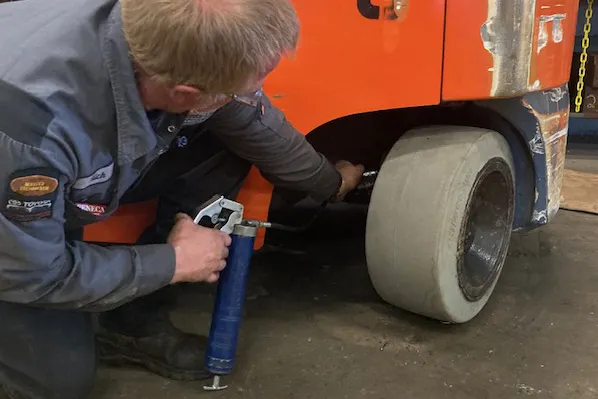A Key Part of Forklift Maintenance: Proper Lubrication

Your forklift requires multiple types of lubricants and oils in order to operate correctly. Choosing the best machine lubricant for each system is a critical factor for prolonging the lifespan of your components and reducing unexpected downtime. To ensure your forklifts operate at their peak, we’ve put together some key information and tips that will help you choose the right products for your equipment.
Forklift grease
Using the proper grease helps reduce friction between moving components and minimizes wear and tear. It’s important to follow the machine lubricant specifications outlined in your owner’s manual, but we recommend sticking to at least a weekly greasing schedule.
Where to use forklift grease
Forklifts are often forced to operate in harsh and even corrosive conditions, so the chain and other essential parts are constantly placed under extreme conditions. It’s important to hit every grease point on your forklift. Your owner’s manual should outline where they are, but here are some of the critical areas that require forklift grease:
- Lifting chain
- Chain pulleys
- Steer links and king pins
- Steer axle mount pivot pins
- U-joints and slip yoke
- The forks
- Upper side shift bushings
- Upper and lower carriage bearings
- Lower mast bearings
Meet or exceed manufacturer requirements
Your owner’s manual outlines the required machine lubricant specifications. We recommend choosing forklift grease that surpasses these minimal standards. Doing so will help you extend the lifespan of your machine and enhance its performance. Don’t have your owner’s manual? Ask our parts department, and we can look up the required grease for your model.
Purge old grease
Whenever you transition from one type of forklift grease to another, be sure to purge the previous grease. Mixing old and new products, which may not be compatible, can potentially lead to serious complications for your equipment.
Hydraulic oil
Another crucial part of forklift maintenance is monitoring its hydraulic oil. This fluid is what allows your forklift to lift and steer, and it needs to be changed at regular intervals. Most manufacturers recommend changing forklift hydraulic oil every 1,000 hours of operation, but it’s important to check the owner’s manual for your specific model.
When to change hydraulic oil
Having insufficient levels of hydraulic oil or degraded or contaminated fluid will decrease a forklift’s lifting and steering capabilities and reduce its overall performance. Here are several indications that you need to change hydraulic oil:
- If abnormal noises are coming from your forklift
- A high hydraulic fluid temperature (above 180 degrees) is detected
- The forklift is operating excessively slowly, particularly hydraulic functions and systems
To monitor hydraulic oil levels properly, it’s important to have operators check the level as part of their daily or pre-shift inspection. That way, they can top up or change the oil before they begin operations and cause any damage by running the hydraulic systems with insufficient or contaminated oil.
Choose zinc free solutions
Zinc is a common additive in hydraulic oils to reduce the wear and tear on components like pumps, motors, and valves. However, zinc itself can induce wear and erosion, as well as pose environmental hazards. Zinc free oils incorporate synthetic additives to deliver the same wear reduction benefits as zinc, without the risk of corrosion or environmental harm.
Use hydraulic oils with water emulsifiers
When water separates from oil, it can lead to significant damage in your forklift. Emulsifiers reduce the risk of water related issues by dispersing water. One of the most important forklift maintenance tips is to choose hydraulic oils containing emulsifiers and avoid oils that claim to repel, segregate, or release water.
Transmission oil
Another key part of forklift maintenance is transmission oil. This oil is used to lubricate transmission system components in order to reduce friction, prevent abrasion and wear, and keep the parts from overheating.
Choose the right transmission oil
Always check your owner’s manual to identify the right type of transmission oil, and understand the weather conditions you’ll be operating in. If you work outside in regions that experience distinct seasons, we recommend using a multi-season transmission oil to minimize the need for frequent changes as the seasons shift.
Handle oil changes with care
Transmission oil change intervals may vary depending on usage and operating conditions, but when you do perform an oil change, take caution to prevent contamination. Thoroughly clean the transmission tank before removing the cap, drain the oil quickly, and keep filter packages sealed until they are ready for use.
Regularly replace your filters
Another critical forklift maintenance tip is to always adhere to the filter change intervals outlined by the manufacturer, so you can effectively prevent damage and wear resulting from contamination.
If you have any questions about forklift grease, machine lubricant, or forklift maintenance in general, contact our team today!
